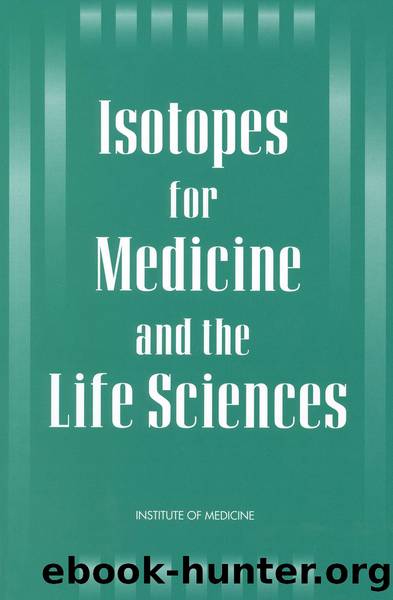Isotopes for Medicine and the Life Sciences by Committee on Biomedical Isotopes

Author:Committee on Biomedical Isotopes
Language: eng
Format: epub
Tags: Health and Medicine: Health Sciences
Publisher: NATIONAL ACADEMY PRESS
Published: 1995-01-27T00:00:00+00:00
Short-Lived Radioisotopes for PET
Because of the very short half-lives of 18F, 11C, 13N, and 15O (110, 20, 10, and 2 minutes, respectively), an NBTF would be unlikely to have a direct effect on the use of these radionuclides. They will generally continue to be prepared with small, on-site accelerators. An important concern related to these radionuclides is the availability of enriched stable target material, especially stable 15N and 18O. This question has been discussed in the section on stable isotopes. (Chapter 2). There is some chance that the 18F, with a half-life of 110 minutes, could be shipped from an NBTF in a major city to facilities in the vicinity (Syncor, Inc., and Mallinckrodt Medical, Inc., have recently established four regional radiopharmacies that produced their own 18F-labeled 2-fluoro-2-deoxyglucose and ship it to nearby hospitals), but the major application of NBTF to these short-lived radionuclides would probably be in the development of high-beam-current targets for the low-energy accelerators that are being proposed. This will be discussed in Chapter 5.
PET could expand beyond the large medical center and become a truly routine clinical tool if some additional sources of positron-emitting radionuclides could be found. One possibility is the supply of medium half-life radionuclides from an NBTF. Candidate radionuclides that have been discussed in the literature (Anderson et al., 1992; Welch and Kilbourn, 1988) include zirconium-89 (half-life, 78.4 hours), bromine-76 (half-life, 16.1 hours), iodine-124 (half-life, 4.2 days), and copper-64 (half-life, 12.7 hrs). Another possibility for an additional source of positron-emitting radionuclide is a "generator" system, similar to the molybdenum-99/technetium-99m generator described in the previous chapter. Such a generator consists of a parent radionuclide absorbed on a column from which a shorter-lived, positron-emitting decay product is eluted by passing a suitable solvent through the column. Table 4-3 lists some candidate parent-daughter systems for PET. It is difficult to predict at this point which of these will prove to be most useful in the future, but given a reliable year-round supply of the parent nuclides, generators could certainly relieve some potential PET users of the substantial burden imposed by an in-house accelerator (Budinger, 1988). However, none of the generator systems will produce isotopes of carbon, nitrogen, and oxygen for incorporation into physiologically active molecules. Thus, the principal advantage of generator-produced positron emitters lies in the ability of PET technology to provide quantitative mapping of certain functions.
Download
This site does not store any files on its server. We only index and link to content provided by other sites. Please contact the content providers to delete copyright contents if any and email us, we'll remove relevant links or contents immediately.
Application of a Novel Technique for Clinical Evaluation of Nitric Oxide-Induced Free Radical Reactions in ICU Patients by Unknown(696)
Rosenâs Emergency Medicine Concepts and Clinical Practice by Ron Walls; Robert Hockberger; Marianne Gausche-Hill; Timothy B. Erickson; Susan R. Wilcox(574)
Oxidative damage to surfactant protein D in pulmonary diseases by Vitality Starosta1 & Matthias Griese1†(410)
Social Science Perspectives on Global Public Health by Vincent La Placa & Julia Morgan(375)
Constructing Canine Consent; Conceptualising and Adopting a Consent-focused Relationship with Dogs by ERIN JONES(330)
Organic Chemistry: An Acid - Base Approach by MICHAEL SMITH(304)
ADVANCED EMERGENCY CARE AND TRANSPORTATION OF THE SICK AND INJURED by Unknown(272)
Saunders Nursing Drug Handbook 2024 - E-Book by Unknown(265)
Davis's Comprehensive Manual of Laboratory and Diagnostic Tests with Nursing Implications by Unknown(250)
Socio-Life Science and the COVID-19 Outbreak : Public Health and Public Policy by Makoto Yano; Fumihiko Matsuda; Anavaj Sakuntabhai; Shigeru Hirota(247)
Human Microanatomy; Cell Tissue and Organ Histology with Celebrity Medical Histories by Stephen A. Stricker(246)
Diagnostic and Statistical Manual of Mental Disorders, Fifth Edition, Text Revision (DSM-5-TR(tm)) by Unknown(246)
Berne and Levy Physiology E-Book by Unknown(237)
Replacing the Dead by Mie Nakachi;(232)
Handbook of Skin Disease Management by Jiyad Zainab;Flohr Carsten; & Carsten Flohr(230)
Access to Medicines and Vaccines in the South : Coherence of Rules and Policies Applied by the European Union Commission by Stephen Kingah(227)
Deep Learning and Medical Applications by Unknown(222)
The Pocket Guide to Sensorimotor Psychotherapy in Context (Norton Series on Interpersonal Neurobiology) by Pat Ogden(219)
Advances and Technical Standards in Neurosurgery by Unknown(216)
